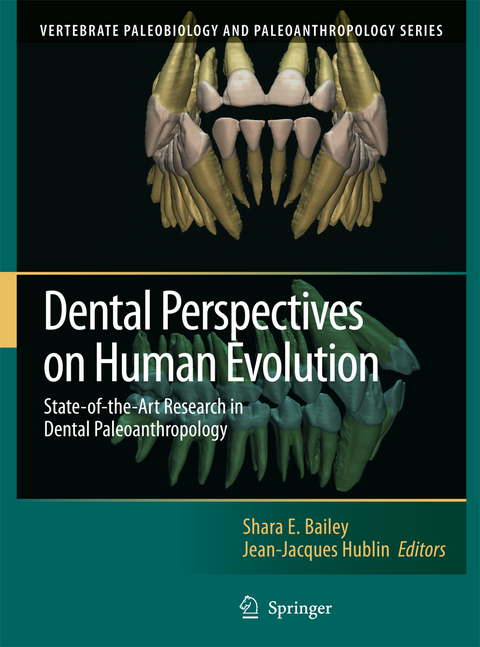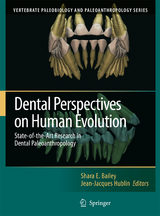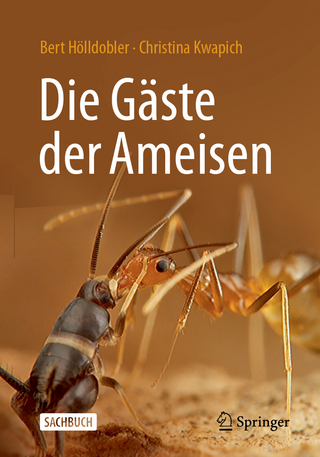Dental Perspectives on Human Evolution
Springer-Verlag New York Inc.
978-1-4020-5844-8 (ISBN)
Shara Bailey: Shara Bailey is an Assistant Professor at New York University and a member of the Center for the study of Human Origins. Her past appointments include Research Scientist at the Max Planck Insitutue for Evolutionary Anthropology in Leipzig (Germany) and Post-Doctoral Researcher at The George Washington University, Washington DC. She completed her PhD in Biolgoical Anthropology at Arizona State University, Tempe in 2002. Dr. Bailey's primary reserach interest is in addressing paleoanthropological questions from a dental perspective. The major focus of her research has been Middle to Late Pleistocene hominns and modern human origins, but her research interests include early hominin and primate evolution as well. Jean-Jacques Hublin: Jean-Jacques Hublin, Ph.D., is currently a Professor at the Max Planck Institute for Evolutionary Anthropology in Leipzig (Germany), where he also serves as the Director of the Department of Human Evolution. Initially his research focuses on the origin and evolution of Neanderthals and he has proposed an accretion model for the emergence of the Neandertal lineage that roots it in time in the middle of the middle Pleistocene. He also worked on the processes associated with the emergence of Homo sapiens and on the interactions between Neanderthals and anatomically modern humans in Europe. He developed the use of medical and virtual imaging in the reconstruction and study of fossil hominids and paid attention to the growth and development issues. He has led field operations in North Africa, Spain and France. In addition to his scientific papers, he has regularly published popular books (with translations in English, Italian, Spanish and Chinese) and articles on the subjects of Neanderthal and early modern human evolution. Significant past research and teaching appointments include: Researcher, Centre National de Recherche Scientifique (1981-2000), Visiting Professor, University of California at Berkeley (1992), Harvard University (1997) and Stanford University (1999), Elected member of the French National Committee of Scientific Research (1991-2000), Professor at the University of Bordeaux (2000-2004), and Deputy Director for Anthropology, Prehistory and Paleo-environmental Sciences, Centre National de Recherche Scientifique (2000-2003).
Dental Evolution and Dental Morphology.- Patterns of molar variation in great apes and their implications for hominin taxonomy.- Trends in postcanine occlusal morphology within the hominin clade: The case of Paranthropus.- Maxillary molars cusp morphology of South African australopithecines.- Gran Dolina-TD6 and Sima de los Huesos dental samples: Preliminary approach to some dental characters of interest for phylogenetic studies.- Neural network analysis by using the Self-Organizing Maps (SOMs) applied to human fossil dental morphology: A new methodology.- Micro-computed tomography of primate molars: Methodological aspects of three-dimensional data collection.- HRXCT analysis of hominoid molars: A quantitative volumetric analysis and 3D reconstruction of coronal enamel and dentin.- Dental Microstructure and Life History.- Inferring primate growth, development and life history from dental microstructure: The case of the extinct Malagasy lemur, Megaladapis.- Histological study of an upper incisor and molar of a bonobo (Pan paniscus) individual.- New perspectives on chimpanzee and human molar crown development.- Portable confocal scanning optical microscopy of Australopithecus africanus enamel structure.- Imbricational enamel formation in Neandertals and recent modern humans.- Dental Development.- Of mice and monkeys: Quantitative genetic analyses of size variation along the dental arcade.- Quantifying variation in human dental development sequences: An EVO-DEVO perspective.- Dental calcification stages of the permanent M1 and M2 in U.S. children of African-American and European-American ancestry born in the 1990s.- A computerized model for reconstruction of dental ontogeny: A new tool for studying evolutionary trends in the dentition.- Dentition and Diet.- An evaluation of changes in strontium/calcium ratios across the neonatal line in human deciduous teeth.- Dental topography and human evolution with comments on the diets of Australopithecus africanus and Paranthropus.- Dental microwear and Paleoanthropology: Cautions and possibilities.- Tooth wear and diversity in early hominid molars: A case study.- 3-D interferometric microscopy applied to the study of buccal enamel microwear.
From the reviews:
"The edited volume is based on the Dental Paleoanthropology symposium which was held in 2005 … . The volume provides invaluable new results, discussions, and synthetic approaches which demonstrate how the study of dentitions can greatly contribute to our knowledge on past human variability and evolution. … Overall it is an excellent volume which contains high quality contributions and is therefore essential to paleoanthropologist, anthropologists, and scholars from various related disciplines. … an invaluable and timely comprehensive account of state-of-the-art research in dental paleoanthropology." Ron Pinhasi, PaleoAnthropology, 2008.
"The resulting edited volume is a significant contribution to the fields of dental anthropology and paleoanthropology … . Much of the work presented here is new and should be significant interest to both students and seasoned researchers in dental anthropology and paleoanthropology. In addition, this is an attractive volume, put together with excellent production values, lovely photographs … and well executed and informative line drawings. … will be of great interest and utility to biological anthropologists, paleoanthropologists, and vertebrate paleontologists." Robert L. Anemone, American Journal of Physical Anthropology, 2009.
" This edited book explores new avenues of research in dental studies of human and non-human primates. The volume focuses on three broad themes – dental morphology, dental development and methodological approaches – and is divided into four sections. In the first section, the chapters focus on the use of new techniques in the study of dental morphological variation and evolution (e.g. direct observation of new traits and two- and three-dimensional techniques). The second section is concerned with dental microstructural morphology and how it can benefit our understanding of a population’s life history. The third section presents new methods for analysing dentalgrowth and development, and chapters here offer varied approaches to examining the ontogeny of teeth including quantitative genetic analysis, radiographic analysis of dental events, and the computerised reconstruction of dental ontogeny. The final section comprises chapters focussing on the most up to date techniques used in evaluating dental attrition and diet. These papers shed light on the diets of our ancestors through investigations of functional morphology, isotopic analysis and microwear studies. As a whole, this book gives a good overview of the diversity of techniques currently being used to understand the dentition, with the ultimate goal of answering questions about hominin evolution." Journal of Human Evolution, 2009.
| Reihe/Serie | Vertebrate Paleobiology and Paleoanthropology |
|---|---|
| Zusatzinfo | XXVIII, 411 p. |
| Verlagsort | New York, NY |
| Sprache | englisch |
| Maße | 210 x 277 mm |
| Themenwelt | Medizin / Pharmazie ► Zahnmedizin |
| Naturwissenschaften ► Biologie ► Humanbiologie | |
| Sozialwissenschaften ► Ethnologie | |
| Sozialwissenschaften ► Soziologie | |
| ISBN-10 | 1-4020-5844-6 / 1402058446 |
| ISBN-13 | 978-1-4020-5844-8 / 9781402058448 |
| Zustand | Neuware |
| Haben Sie eine Frage zum Produkt? |
aus dem Bereich




